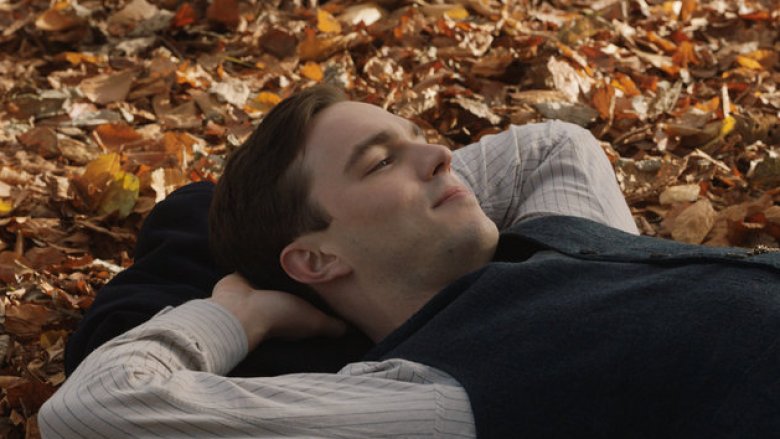How Tolkien Ignored The Author's True Story
Trying to tell someone's life story — even just a section of their life — is tricky business. It's impossible even with the best of intentions because you're just not going to be able to fit everything in. Important stuff is bound to be left out, and sometimes, those important things are so big they're worthy of their own movie.
The Tolkien biopic is no exception. Even though it focuses on the author's formative years and young life, there's still plenty that gets left out and just sort of glossed over. And some of it was a pretty big deal.
Jonathan Ronald Reuel Tolkien's life was pretty incredible, from his boyhood struggles with poverty and his mother's untimely death to his time in the trenches of World War I, it's easy to see how the lure of a fantasy world where anyone — no matter how small — could make a difference might leap fully fledged into his imaginative mind. There's something hopeful and beautiful about that, and the life it came from? It was complicated.
When Tolkien left the Shire
J.R.R. Tolkien was young when he was uprooted from the idyllic, rural landscape that was Sarehole, and in the film, we see his distraught mother telling him they were going to have to move into the dark, industrial smog of Birmingham. Tolkien is inconsolable, and it's no wonder — it's a huge change. But we don't find out just why they have to move.
Tolkien was born in South Africa, but according to Angelus, neither Tolkien nor his mother could handle the rough climate. Mabel and her children returned to England for a short vacation and while they were there, Arthur Tolkien died. The little family was left with no way to support themselves, and while they did have extended family in the area, something happened in 1900 that would prove catastrophic: Mabel and her boys converted to Catholicism.
That conversion and her devotion to her new religion completely ostracized them from the rest of the family, and she died only four years later after being diagnosed with diabetes. Tolkien would write that her death came on the heels of "killing herself with labour and trouble to ensure [her children] keeping the faith," and it was after that estrangement from relatives that Mabel and her boys moved to a Birmingham suburb and, according to the Tolkien Society, found true family in the Catholic Church.
Why did he agree to ditch Edith?
Anyone who has ever tried to get between a pair of teenage lovebirds knows just how impossible it can be, so when Father Francis Morgan orders a young Tolkien not to see the orphan girl he's fallen in love with, it seems strange that he agrees with barely an objection. But there's way more to the story than what's depicted on screen.
Father Francis wasn't just a priest, he was appointed the boys' official guardian by their mother before her passing. According to Aleteia, Tolkien was acutely aware of the price his mother had paid for her conversion to Catholicism. He saw her as a martyr for her faith, estranged by her family and willing to suffer and sacrifice so he and his brother might find comfort in the church. Turning his back on the wishes of his priestly guardian may have strained that relationship, but knowing just how important faith was to his mother and, in turn, to him, makes it easier to understand why he would have given in.
According to the History Collective, there was something else at work here. While the film stresses that the communication ban is to allow him to pay more attention to his studies, Father Francis had two other reasons for opposing the pairing: the age difference and the fact that Edith Bratt was Protestant (played as an offhand joke in the film).
The woman who helped shape his love of language
In the film, J.R.R. Tolkien's academic career changes paths when he meets Professor Wright, the author of a language primer he's reading. While it's certainly true that the professor had a lasting impact on him, there's another person who was equally — if not more — important, who doesn't appear in the movie at all: the professor's wife, Elizabeth Wright.
Elizabeth Wright was a scholar and author as well, and at the same time she was finishing up her book Rustic Speech and Folk-lore, a young Tolkien was often hanging out at their home studying with them both. According to CS Lewis and the Inklings, Mrs. Wright's work was in a part of the field that Tolkien would tap into repeatedly. She was studying words that "ran away from a public career a century or two ago" but were still occasionally used.
One of the examples she used in her book was "attercop," an Old English word made from a combination of words that meant (among other things) "poison" and "spider." Tolkien fans will recognize Attercop from his own writings, where it's used by Bilbo in reference to some seriously giant spiders. It's not the only word Tolkien plucked from obscurity, something he practiced with the oft-overlooked scholar he often exchanged letters and ideas with.
The time in the trenches
The film Tolkien doesn't make it clear just what his role in the war was. As you might expect, an Oxford man wasn't just a grunt on the ground floor of the trenches, and according to Oxford's World War I records, Tolkien joined up with the Oxford University Officers' Training Corps just after finishing his degree.
He and his battalion, the Lancashire Fusiliers, were dispatched to France in June 1916, and Tolkien's official job duties included acting as a battalion signaling officer. That basically meant he was responsible for reporting the movement of troops in the field to senior officers, until he — like so, so many other young men — was sent to the front lines of the Battle of the Somme. According to the Tolkien Society, he spent around four months living in the trenches, where he saw death and horrors that undoubtedly influenced the descriptions of the horrors of Mordor he would eventually write.
Seeing it through to the end
When Tolkien was sent to the front lines, it was into staggering violence. An estimated 20,000 British soldiers were killed on the first day of the Somme offensive, and another 37,000 were wounded. It wasn't long after he got to France that he met up with his old friend, Geoffrey Bache Smith, and was almost immediately in the midst of what he called "the universal weariness" of war.
A few months later, Tolkien fell ill with trench fever, a potentially deadly disease caused by the lice that infested the unsanitary conditions of the trenches. He checked in sick on October 27 and was back in Birmingham on November 10, but despite the impression given in the film, that wasn't the end of his wartime service.
According to the JRR Tolkien Encyclopedia, he spent the next few months in and out of various hospitals and eventually joined up with a battalion responsible for training new recruits. He transferred a few more times, spent another stint in the hospital, and then two things happened: Edith gave birth to their first son, and he was transferred to a coastal defense force. Another relapse in June 1918 saw him officially deemed unfit for service, but it wasn't until July 16, 1919 — months after Armistice Day — that he was officially demobilized and granted a disability pension.
Would a walrus by any other name...?
After the end of World War I, Tolkien became a teacher, as the film shows, but not right away. He had another job that doesn't get a mention in the film, and that's a shame because it's pretty cool.
Starting in 1919, Tolkien worked on the staff of the Oxford English Dictionary and was one of the assistants to Henry Bradley (one of the editors of the dictionary's very first edition). While he was there, he seems to have been given some particularly difficult words to work on, mostly in the section between "waggle" and "warlock."
What words did Tolkien work on? Words like "walrus," "walnut," and "wampum." He took it very seriously, too — Oxford's Bodleian Library has a notebook that contains pages and pages of notes he wrote on "walrus" alone, and he continued to do his deep dive into the meaning and etymology of the words even after he left the position in 1920. Oxford records show that while he was working on the dictionary, he was also teaching undergraduate students and building up his reputation as a teacher, which he would, of course, eventually become in an official capacity.
The lion and the hobbit
Tolkien touches on the title character's post-war life at Oxford, but one of the things that's left out is the fact that he was good friends (and occasionally, frenemies) with another Oxford scholar and fantasy writer: C.S. Lewis.
According to Salon, the two bonded not only over their love of myths, legends, and language, but also over their shared experiences in World War I and their love of stories where heroes fought against insurmountable odds. What they argued over was faith, with Lewis trying not to be pulled back into the Christian world he had left behind and Tolkien arguing for the truth in religion. The Christian overtones in Lewis' most famous works make it pretty obvious that Tolkien was super convincing ... although Tolkien wasn't shy in saying that he wasn't a fan of the Narnia series in the least, condemning it for being too obviously Christian.
According to the Telegraph, they had another major thing in common: They both hated Walt Disney. A series of private letters between the two condemned him for — among other things — his depiction of the dwarves in Snow White and his "unoriginal" Evil Queen. Nothing brings people closer together than a mutual hatred.
He had a thing for male-only societies
When Tolkien was attending King Edward's, he made three friends who would embody his ideals of friendship. They formed the Tea Club, Barrovian Society, or TCBS, and if you're just going by the film, it seems as though that's the only noteworthy male-only literary society he was a part of.
But Tolkien celebrated groups like that, and he was a part of a couple. One was the Inklings, which was an Oxford-based group that started with Tolkien and C.S. Lewis. They started meeting for a pint on Monday mornings and discussing things like literature, theology, whatever poetry they happened to be working on, or what was going on at the school. Eventually, they invited other writers along to their meetings as well. C.S. Lewis had this to say about the group: "What I owe them all is incalculable. Is any pleasure on earth as great as a circle of Christian friends by a good fire?"
And there's even one more: the Coalbiters. According to the Inklings' blog, Tolkien originally named the group "Kolbitar" as a reference to the practice of sitting around a roaring fire (so close they're almost biting the coals) and telling stories. That society was focused on the Old Icelandic sagas, myths, and language, and even those with a cursory knowledge of Tolkien's work knows how important that was to him.
Teaching? Eh, it pays the bills
At the end of the film, a content, happy Tolkien is seen surrounded by his loving wife and their children, and it's implied that all is right in his world. He's a teacher at Oxford by the end of the film, but letters penned by the real Tolkien hint at the fact that he wasn't actually all that enamoured with teaching.
We can start with the fact that he wrote the opening line of The Hobbit while he was supposed to be grading exam papers. He would later write that the only thing he remembered about starting to write the book was that he was in the middle of the "everlasting weariness of that annual task." And according to the Guardian, he wrote to fellow teachers about just how draining it could be. In 1964, he wrote a response to a young teacher who had originally written to him to tell him that his stories had captured the imaginations of her normally unruly class. He typed her a letter in response, then added this at the bottom:
"All teaching is exhausting, and depressing, and one is seldom comforted by knowing when one has had some effect. I wish I could now tell some of mine (of long ago) how I remember them and the things they said, though I was (only, as it appeared) looking out of the window or giggling at my neighbour."
The trauma of war and the Ring
It's already difficult to comprehend the horrors of war, but when it comes to the trenches of World War I, it's completely unimaginable. And the tragedy continues even after the last shots are fired, carried with those who were there. Perhaps to keep things from getting too grim, the film didn't truly get into the lasting impacts of war.
All seems well and good once Tolkien returns to Blighty, and according to an article in Mythlore: A Journal of JRR Tolkien, Tolkien repeatedly professed that his time in the war had next to no influence on his writing — save for the Dead Marshes owing something to the devastated, post-Somme landscape of France. But elsewhere he wrote, "An author cannot of course remain wholly unaffected by his experience. ... One has indeed personally to come under the shadow of war to feel fully its oppression." That was from a foreword to Lord of the Rings, and it's argued that Frodo's strange, distant behavior at the end of The Return of the King — behavior that seems so inexplicable and so out-of-character — is Tolkien's depiction of something he would have seen often, and called shell-shock. Today, it's called post-traumatic stress disorder.
There's no denying that the war — especially what Tolkien called "the animal horror of trench warfare" — left its mark, but to be fair, it's also not something that can be covered in a two-hour movie.
Tolkien the environmentalist
In Tolkien, we see snapshots of just how big an impact the beauty of the natural world has on the famous fantasy author. He mourns the loss of afternoons in the woods of Sarehole, sure, but as far as the film is concerned, that's the anguish of a boy being taken from his home. What it ignores are the snapshots that shaped Tolkien's environmentalist views.
According to American Forests, the devastation he witnessed during the Battle of the Somme and the destruction wrought by the machines of war brought him to the conclusion that industrialization caused a distinct divide, and forests were something different: They were a refuge. In the days he spent recovering from the illness he contracted during the war, he and Edith spent time in the forest around Roos. It's a scene depicted in the movie: she dances for him among the trees, and it inspired the tales of Luthien and Beren.
Even at Oxford, he had a tree that he was so fond of it became known as "Tolkien's tree." It was a black pine whose twisting branches were said to be an inspiration for the Ents, and unfortunately, the tree didn't have a happy ending. It was planted in 1799 and cut down in 2014 after branches began to fall. When the announcement was made, Oxford academics acknowledged Tolkien's lifelong love of trees — a love that's more than just between the lines.











